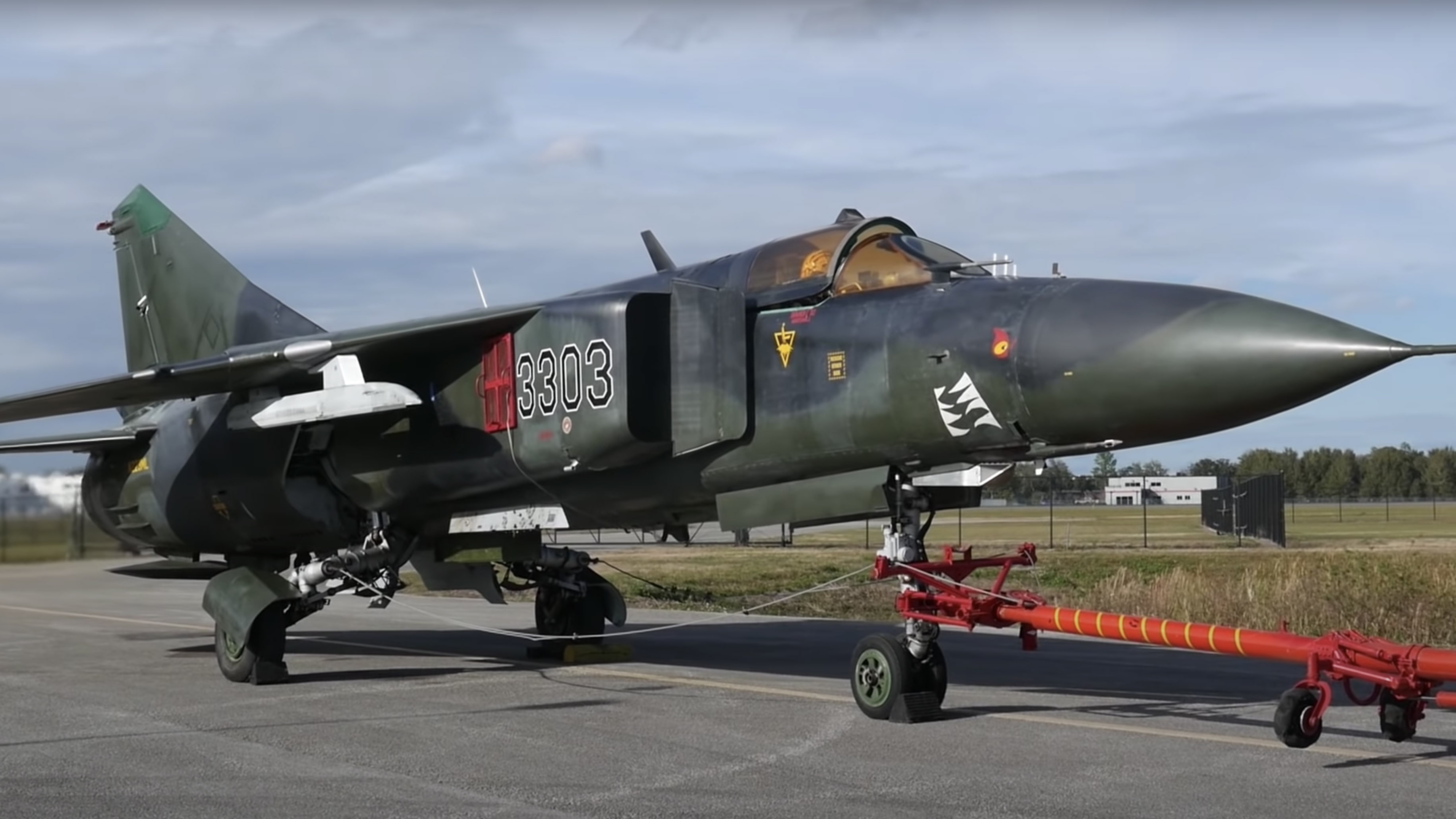Will “Psycho” Ward knows his way around Soviet-designed fighter jets better than most in the Western world. Now, we can also benefit from his knowledge about the swing-wing MiG-23ML Flogger in an excellent walk-around video of the fighter that explains its many unique features and characteristics in detail.
With 60 different types in his logbook, including the Korean War-era MiG-15 and the supersonic MiG-21, as well as the American-made F-104 Starfighter and A-26 Invader, Ward is a true aficionado of Cold War combat aircraft. In the roughly half-hour walk-around video of the MiG-23ML—courtesy of our friends over at the always awesome Airshowstuff.com—which includes running up the engine and demonstrating its variable-geometry wings, he imparts expertise down to the minutiae of the different pitot tubes and access doors. But what really comes across is his enormous enthusiasm for the Flogger, and for Soviet jets in general, along with all their ‘special’ quirks.

In the process of taking the viewer around the ex-Czechoslovakian Air Force MiG-23ML Flogger-G at Lakeland, Florida, Ward also busts a few myths about the jet, which has, it must be said, not the best reputation in the West. This is the product of a general misunderstanding of how Soviet-era jets were designed and expected to be used, but also the less-than-stellar combat performance of (mainly earlier models of) Flogger in combat in the Middle East, in particular.
Then there are the hair-raising tales of the MiG-23s flown under conditions of great secrecy in the United States by the “Red Eagles” of the 4477th Test and Evaluation Squadron, which you can read about here and here.
The early MiG-23s operated by the Soviet Union and its allies were, it’s true to say, less than perfect. These were demanding jets, rushed into service with limited avionics, and they were not necessarily highly appreciated by their pilots and maintainers, whether in the hands of Soviet or export operators, or indeed the “Red Eagles,” who lost two of their own to fatal MiG-23 accidents.

With all that in mind, it’s worth looking at some of the key points that Ward raises in his highly informative video presentation, the caption for which suggests that there are plans to return the Flogger to the air in the United States in the future.
The Flogger-G is not your grandmother’s MiG-23
While the MiG-23 started out as a replacement for the classic MiG-21 Fishbed, the MiG-23ML that we see in the video, and the further improved MiG-23MLD that followed it, are “completely different” from the previous-generation MiG-23S, M, and MS that were “rough airplanes.” The very first Flogger fighters were introduced to service without their intended radar, or even medium-range air-to-air missiles, while the MiG-23ML was a much more modern proposition, with better handling and maneuverability thanks to a more powerful engine and lighter airframe. The avionics and weapons were updated, too.
In the four years that the MiG-23ML has been in his charge, Ward says he has not come across any pilot or maintainer that didn’t “absolutely just love this airplane.”

The MiG-23ML that we see in Florida still has its J-band radar installed. Known to NATO as High Lark 2, this operates across 10,000 to 20,000 megahertz and has a range of 53 miles, Ward says. It was actually a very respectable piece of kit for its time, with a look-down shoot-down capability to detect, track, and engage low-flying targets, and electronic counter-countermeasures to defeat enemy jamming. In Ward’s words, it’s “outstanding.”
The landing gear is a brutalist work of art
The “incredibly rugged” landing gear on the Flogger is seriously tough, enough to operate from rough and even unimproved airfields and to handle the demands of operating with up to 6,700 pounds of ordnance hanging from the jet. Brakes on all three wheels allow “very short landings,” aided by a braking parachute in the tail, and the ingenious way the undercarriage deploys and retracts through a process of hydraulic rotation is something worth looking at in itself — as in the video below. There’s also a ventral fin that pops out once the gear is retracted to provide stability.
No, the intake design wasn’t stolen from the F-4
Ward also takes on another Western fallacy about the MiG-23, which supposes that the designers at Mikoyan-Gurevich took the engine intake design from the F-4 Phantom II and used it on the Flogger. Not true, says Ward, who points out that, while the form and function are similar, the MiG-23 has a completely different intake with different dimensions.
The cleverly engineered intake serves to manage the turbulent boundary layer airflow over the airframe, with a splitter plate and variable ramps in the intake ensuring the airflow is decelerated to subsonic speed before feeding the engine, preventing unstable supersonic air from slamming into the engine and maintaining efficiency.

The Soviets stuck with turbojets, but for good reason
As for the engine, this is an impressively titanium-clad R-35 turbojet, pumping out 28,600 pounds of thrust at full afterburner, propelling the Flogger-G to a top speed of Mach 2.35. The MiG-23 series went through a series of increasingly more powerful and reliable powerplants, from the early R-27 to the R-29, and finally the R-35.
In contrast to Western fighters of the same period, which mainly relied upon more efficient turbofans, the Soviets chose to retain a turbojet. However, Ward judges it was “probably one of the best turbojets ever made,” and “magnificently reliable.” Advantages of the turbojet include not only its simplicity but, for its time, a faster throttle response, meaning the engine reacts more quickly when the pilot demands rapid thrust increases or decreases.
Ward puts the R-35 in the same category as the American Pratt & Whitney J75 that powered the F-105 Thunderchief and F-106 Delta Dart but notes that the Soviet engine produces the same power while being 1,000 pounds lighter. Ward has had no issues with the engine, and he is also full of praise for the integral TS-21 turbostarter, a 70-horsepower compressor that allows the engine to be up and running in a time of five to 15 seconds.

A swing-wing with a difference
The MiG-23, as Ward explains, went through three different generations of wing design. The first of these had a simple straight leading edge with three flaps. Next came a cleaned-up version of the wing, with no flaps but a dogtooth on the leading edge for better handling at high angles of attack. Finally, by the time of the MiG-23ML, the third-generation wing combined four flaps and a dogtooth, part of an overall airframe design that was tailored to maneuver at up to 8.5g.

Western accounts often describe the MiG-23 wing as having three different sweepback settings: for takeoff, landing, or low-speed cruise; high-speed cruise; and for combat. In fact, as Ward explains, the pilot can select from an unlimited amount of wing sweep settings and the aircraft is “very tolerant” when it comes to moving the wing around. The process of moving from minimum to maximum sweep takes 18 seconds and, once the wings are swept back, the stabilators (all-moving tailplanes) deflect to manage roll requirements. The wings, although clearly slender, also contain a total of six wing fuel tanks, which in turn feed three tanks in the fuselage.
All in all, Ward makes a very good case for the MiG-23ML being a “beautiful artwork” of a Cold War fighter. Certainly, it is far from the crude and brutal stereotypes often found in Western publications.
Contact the author: thomas@thedrive.com
